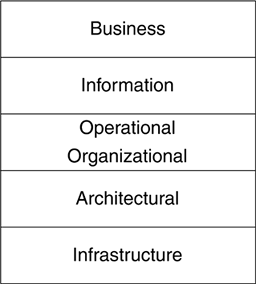Building an Enterprise Architecture
| The term architect was derived from the building trade. The building of a corporation's nervous system is directly comparable to building a house. One may say, "I have no clue about how to build a $50 million dollar skyscraper, let alone a $50,000 house." Yet the response to both tasks is simple: They are accomplished by creating blueprints. Blueprints show how a house will be constructed. They provide multiple views, each expressing its own level of detail. One view of the house may include all the electrical circuits that are of extreme value to an electrician. Likewise, the plumber will need a blueprint to show where all the pipes and water should go. Enterprise architecture diagrams the blueprints for all of the people within an organization so they know how to build an agile enterprise. The enterprise architecture blueprint is meant to provide sufficient detail to allow the idea to become a reality when put in the hands of skilled professionals, much as a house blueprint does. We do not mean to imply that building a skyscraper is as easy as building a house. A decade ago, Garlan stated, "As the size and complexity of software systems increases, the design problem goes beyond the algorithms and data structures of the computation: designing and specifying the overall system structure emerges as a new kind of problem. . . . This is the software architecture level of design." [Garlan 1992]. Figure P-2. Architectural composition.
Enterprise architecture within this context seeks to solve for intellectual manageability. Architecture of large projects and their complexity arise from broad scope, massive size, novelties of the minute, currently deployed technologies, and other factors. The goal of enterprise architecture in this situation is to provide a manner to hide unnecessary detail, simplify difficult-to-understand concepts, and break down the problem into better-understood components (decomposition). Complexity also arises within organizations due to processes used in building the system, the number of people who are involved with construction, the introduction of the possibility of outsourcing and geographically dispersed teams, and the organizational funding model. Ideally, enterprise architecture can assist, but not eliminate, the management of the process by providing clearer separation of concerns, enhancing communications, and making dependencies more manageable. Building enterprise architecture is difficult but not impossible, as long as one sticks to architectural principles. The architectural blueprint defines what should be built, not how or why. Project plans document the how, and their creation is best left to individuals who have studied project management. The why is best left to one's business customer, as all architecture should be business-driven. A word of advice: A good architecture provides agility but also provides constraints. A highly successful architecture will remove points of decision from those who are traditionally accustomed to having a free-for-all, making decisions impulsively or reacting to the opinions of those who are uninformed. Good architects will see things that make their heads hurt, but their aspirin is in knowing that their hard work and persistence will result in the reduction of future problems. Helping others see the value of enterprise architecture is crucial, as it brings benefit to the enterprise even if decisions have local consequences. |
EAN: 2147483647
Pages: 148
